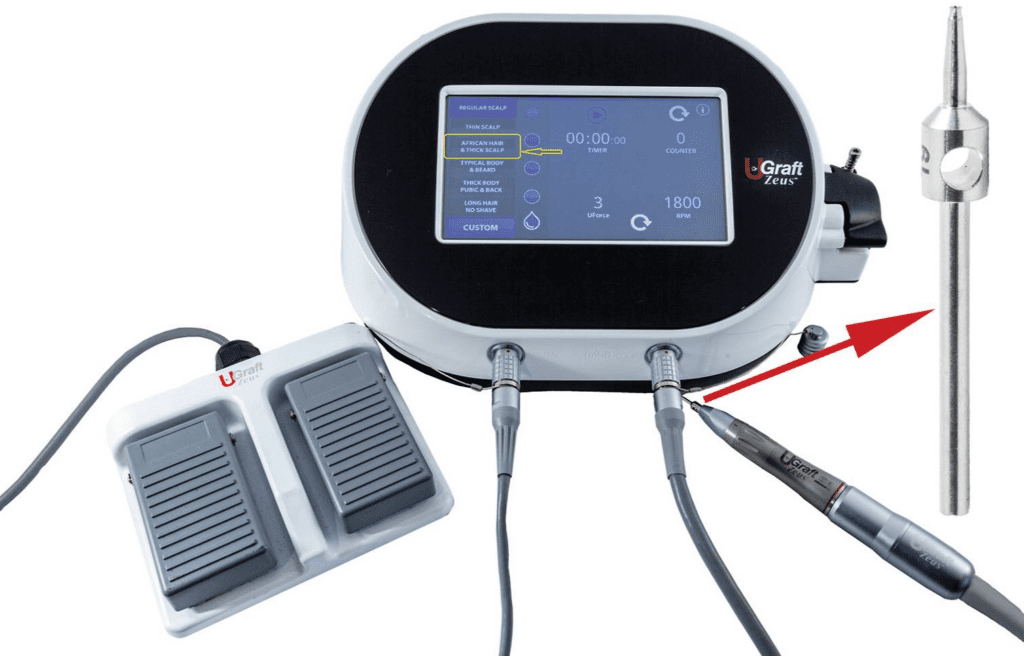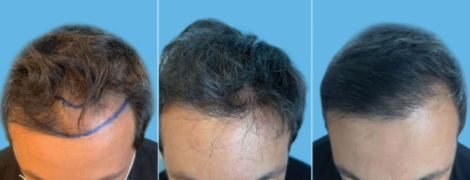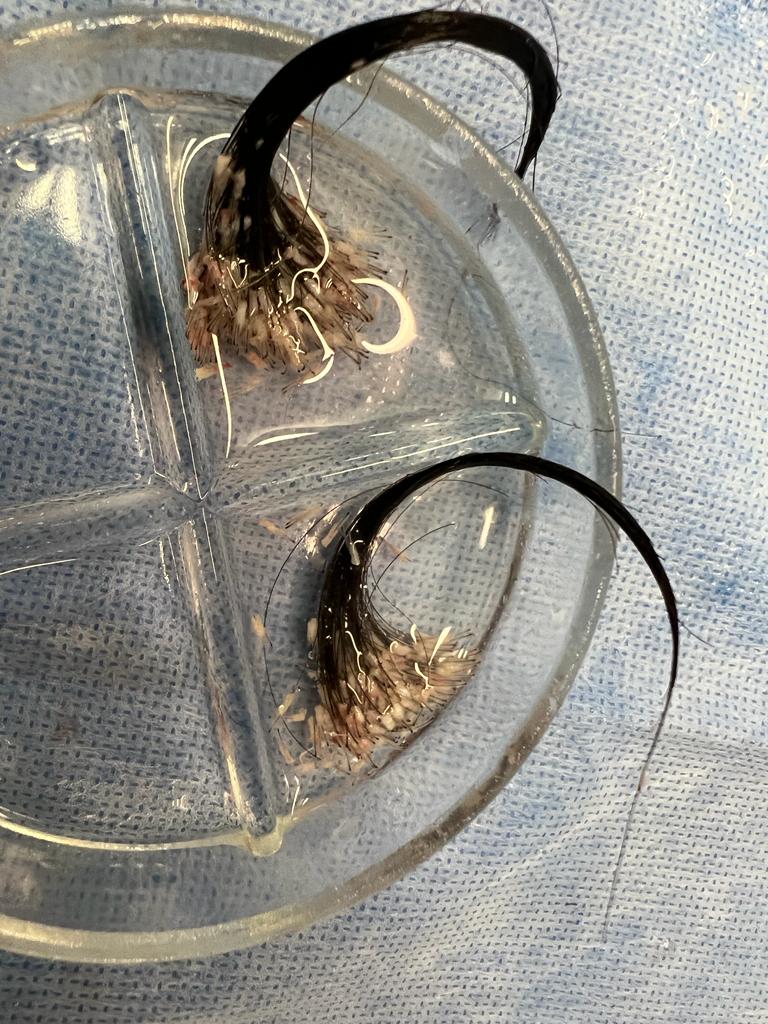UPDATE: A recent study evaluates a new skin-responsive technique for no-shave long hair follicular unit extraction (LH-FUE) that eliminates the need for recess-tipped punches. The study uses a skin-responsive FUE device, the UGraft Zeus, and involves retrospective analysis of patients across five international clinics, showing promising results in terms of reduced graft transection rate (GTR) and shaft break rate (SBR), as well as high patient satisfaction. Surgeon willingness to adopt this technique significantly increased due to its effectiveness across diverse hair and skin types, suggesting improved procedure speed and ease of use. Overall, the findings indicate the potential for widespread adoption of this innovative approach in LH-FUE procedures. Find the Clinical, Cosmetic and Investigational Dermatology publication on Long-Hair FUE (LH-FUE) in the References.
Long hair follicular unit extraction (FUE) is a hair transplant method that permits patients to keep their preferred hair length during and after their procedure.
In a traditional Follicular Unit Extraction surgery, patients are required to have their entire scalp shaved as the first step. Technicians cut hair shafts to the length of short stubble. These shaved hairs are used as visual cues to help determine the position and alignment of the individual hair follicle units.
However, when the hair is left at its original length, it is more challenging for the surgeon to determine the correct angle and alignment of each follicle. Closer attention is needed to properly align the punch to extract each graft.
During the extraction phase of long hair FUE, technicians keep the surrounding hair parted as the surgeon extracts individual grafts using a punch within the donor area.
The donor grafts are then inserted into the recipient areas by carefully creating slits in between the existing hairs.
Different Methods of Non-Shaven FUE
1. Partial Shave FUE
- Partial Shave FUE
- Pretrimmed Hair Non-Shave FUE
- Long Hair Shafted Long Hair FUE
Partial Shave FUE
Here patches or bands of scalp zones are shaved in a manner that allows for the surrounding hair to easily cover the defect. This is possible in individuals with plenty of hair that is long, typically women. The downside to this includes the limited amount of areas that can be shaved and camouflaged afterward. This places a limit on the number of grafts that can be harvested in a given session. There is also a risk of removing too much hair from the shaved patches. Finally, a patchwork of harvested areas is the end result which might not give an even-looking donor area at the end of the day. All the retrieved grafts are short-shafted as in standard follicular unit extraction (FUE) methods.
Pretrimmed Hair Non-Shave FUE
This is done by clipping individual follicles that are thus earmarked for extraction shortly after. Typically, the patient is brought into the clinic one day before, and the medical assistants spend hours going through the entire donor meticulously and clipping individual hairs that have been earmarked for hair vesting the next day. The FUE practitioner then goes through the donor to harvest all the short-clipped hairs they can find using regular FUE techniques. The extra task is just the identification of the clipped follicles. The rest of the process is the same as a typical FUE. All the retrieved grafts are short-shafted as in standard FUE methods.
Long Shafted Long Hair FUE
In this non-shave method of FUE, there is no shaving or trimming of any kind involved. The FUE practitioner seeks to obtain long grafts for implantation. The donor area is never shaved, and the grafts are implanted into the recipient with long shafts. This enables the patient to immediately preview what their final results may look like several months later when the hair transplants have grown in. The advantages are as follows:
- Immediate preview of results
- Less downtime since the long-shafted grafted hairs will minimize the obviousness of the scabbing and redness in the recipient area
- Less downtime since the donor area is not shaved.
Technologies for Unshaven FUE
There are two main types of technologies for performing long hair FUE
- Notched or slitted punch for long hair FUE
- Non-Notched Intuitive Punch for Long Hair FUE
Notched or Slitted Punch Technologies for Long Hair FUE
Examples include the Mamba or Trivellini FUE system and the Jae PAK season technology.
These long-hair FUE technologies are based on concepts developed by Otavio Boaventura and Jae Pak, who created punches with slits and notches in their perimeter. To perform FUE, the provider will position the punch to such that the notch or slot is entered by the targetted hair. The punch then drives into the skin without cutting the hair, which is accommodated and protected by the notch or slot.
Non-Notched Intuitive Punch technologies for Unshaven FUE
This represents an advancement in long-hair FUE technology and features the UGraft Zeus technology. This technology is the only all-purpose FUE device at the time of writing this article since it is the only device that is capable in all known FUE scenarios using only one punch design (The intelligent Punch) and only one punch driver (The Zeus). The Intelligent punch possesses neither a notch nor slit; this the operator does not need to position the punch for the sake of notches or slots. Any point in the circumference of the punch is capable of engulfing the follicle exit point and extracting long hair-shafted grafts. All the operator needs to do is select the “long hair FUE” tab on the dashboard.
VIDEO: This video illustrates how the two mechanisms of long hair FUE operate and how they compare to each other
How To Perform Long Hair FUE. Non Shave FUE Made Easy – Zeus
How To Perform Long Hair FUE. Non Shave FUE Made Easy Using the UGraft Zeus
Dr. U’s Extraction Technology for Long Hair FUE
“One system for all FUE, including long-hair.” – Dr.U on his hair transplant system, the Dr.UGraft Zeus
By gathering direct experienced-based knowledge, he has developed an advanced, patented hair transplant technology called the Dr.UGraft Zeus Used with its Intelligent punch (also invented by Dr.U), this all-in-one FUE system excels at all types of Follicular Unit Extraction challenges, including the difficult intricacies needed to successfully perform long hair FUE procedures.
With the UGraft Zeus, there is no need for meticulous alignment of the punch, as there is no slit on it. The flared design of the punch compensates for most misalignments, and the corkscrew mechanism – created by the texturing of the punch, moves the hair follicle with the graft in response to the force, speed, and positioning of the punch. The combination of those factors makes hair angle irrelevant.
Hair Transplant Graft Counts For Long Hair FUE Procedures
With U-FUE procedures, the redness, scabbing, and wounds from the hair transplant extractions and insertions remain hidden by the patient’s hair. Longer hair serves to conceal the marks of surgery. This limits the number of grafts that providers can remove in one procedure.
Some doctors will only harvest a maximum of 500 grafts in a single session. Others stipulate that if the donor count needed to meet the patient’s goals exceeds 2000, then the overall hair transplant procedures should be divided into multiple sessions.
FUE Versus Unshaven FUE For No Downtime Hair Transplant
The healing and recovery time following a hair transplant procedure is strictly for the cosmetic improvement of the donor and recipient areas on the scalp. Patients are able to retain their mobility and overall ability to function.
After a Follicular Unit Extraction procedure, scabs will form on the recipient sites. The reddish crust that develops is made of dried blood, protein, and tissue from the skin. It takes between 7-10 days for the scabs to fall off. However, it can take up to 14 days for the skin to heal. During this time, patients often choose to wear a loose-fitting hat, beanie, or other head covering of their choice.
With unshaven FUE, also referred to as no-shave FUE, patients are able to keep the scabbing and redness of donor and recipient sites adequately hidden by their own hair. Therefore, recovery and time off would not be needed for the skin to heal. Patients are free to return to work the next day.
Unshavn FUE or Long-Haired FUE, Who Is It For?

Patients who feel strongly about being able to resume their normal day-to-day activities without anyone noticing drastic changes often choose long hair FUE.
This is often the case for individuals who fulfill public roles in their careers. Therefore, they have to maintain the right image and appearance at all times since they are constantly in the public eye. Examples might include:
- Celebrities
- Public media figures
- Sales and client management representatives.
- Models, actors, actresses.
Shaving their head would be drastically disruptive to their line of work. And undoubtedly, the self-consciousness they experience would be immensely aversive. Unshaven FUE offers individuals an alternative to avoid these situations and issues.

Discrete Hair Transplants
Aside from work-related complications, there are also patients who are interested in keeping their hair transplant procedures a secret from their friends, family, and even their significant others and children!
One of Dr.U’s patients had one of those conventional hair transplants with the shaved head and everything in between. However, he was not satisfied with the results. Months after his initial surgery, he noticed his hair was still thin, particularly on the crown and mid-scalp. He was also left with a scar.

“Can you fill in any gaps needed to thicken part of my hair,” he asked Dr. Umar as he showed him his sparse hair. He wanted Dr.Umar to fill in the remaining sparse gaps.
More than anything, the patient wanted to be discreet about his hair transplant surgery. He opted to take advantage of Dr.U’s Long Hair FUE procedure and the technological advances Dr.UGraft Zeus’ hair transplant systems offered.
Dr. Umar realized the patient didn’t have enough donor hair for the hairline, temples, top, and crown. The procedure required grafts harvested from the chest, abdomen, and beard. A total of 4500 long-haired grafts were extracted.
The patient was able to resume his normal daily schedule without anyone knowing that he had a hair transplant procedure.
U-FUE For Men and Women
Men and women can benefit from the innovations the Long Hair FUE has to offer. Consequently, because women typically wear long hairstyles, the Long Hair FUE may very easily be the go-to option so that they don’t have to shave their heads. The longer the patient’s hair is, selective trimming becomes a necessary part of the procedure. Women with long hair can opt for partial shaving as part of a regular Follicular Unit Extraction procedure. Dr. Umar, for example, will shave a rectangular, horizontal section on the back of the head from which to extract donor grafts. The long hair above this area can easily keep this region hidden.
If you are interested in learning more about unshaven or long-hair FUE, use the button below to submit a free consultation.
Frequently Asked Questions – Long Hair FUE
How much does long hair FUE cost? Is it more expensive than regular FUE procedures?
Unshaved FUE does involve more time than regular Follicular Unit Extraction procedures. Therefore these procedures do cost more per graft, by up to 25 percent.
Do all FUE practitioners offer U-FUE?
No, not all FUE surgeons are able to offer unshaven or long FUE. This procedure requires a certain level of expertise, skill, and experience due to its highly specialized nature. However, the features of Dr. U’s Dr.UPunch i and intuitive FUE help to make these procedures much easier, as well as reduce the learning curve.
Is it possible to undergo long hair FUE for the hairline and temples since these regions are highly visible around the face? How can I disguise work in these areas?
Understandably, the hairline and temples frame the upper part of the face. However, the ability to keep these regions hidden often depends on the hairstyle of the patient. Obviously, with longer front lengths, it is much easier to conceal the recipient areas. However, Dr. Umar finds that inserting a very small number of grafts along the very outer edge in separately scheduled surgery sessions can help address mid-hairline and temple recession.
What Norwood classes are eligible for unshaven FUE?
There are no strict criteria for Norwood stages that would qualify for unshaved FUE procedures. Past Norwood 2, it may be harder to hide the recipient area wounds with longer hair in the hairline. However, some patients are mostly concerned with the issue of shaving their heads, choosing U-FUE to avoid this altogether. The SDA (safe donor area) on the lower region of the scalp can remain hidden by longer hair. If hiding the recipient area with long hair is a challenge, patients may opt to keep this region concealed with hats or head coverings until they experience growth.
Unshaven FUE is discreet and effective, thanks to the Dr. U Hair Clinic. If you have more questions, you can submit them by clicking the button below:
Read more on Long-Hair FUE here.
Further Reading
The hair transplant process, self-care after a procedure, when to start expecting growth, and more
References
- Umar, S. et al. (2023) No-shave long hair follicular unit excision using an all-purpose skin-responsive device, Clinical, cosmetic and investigational dermatology. Available at: https://pubmed.ncbi.nlm.nih.gov/38144157/ (Accessed: 29 December 2023).
- Jokic, N. (2023) There’s a lot of fake hair in Hollywood, so here are 12 male celebs who have been candid about using wigs and surgery to get their locks, BuzzFeed. Available at: https://www.buzzfeed.com/natashajokic1/celeb-hair-transplant-wigs (Accessed: 17 January 2024).
